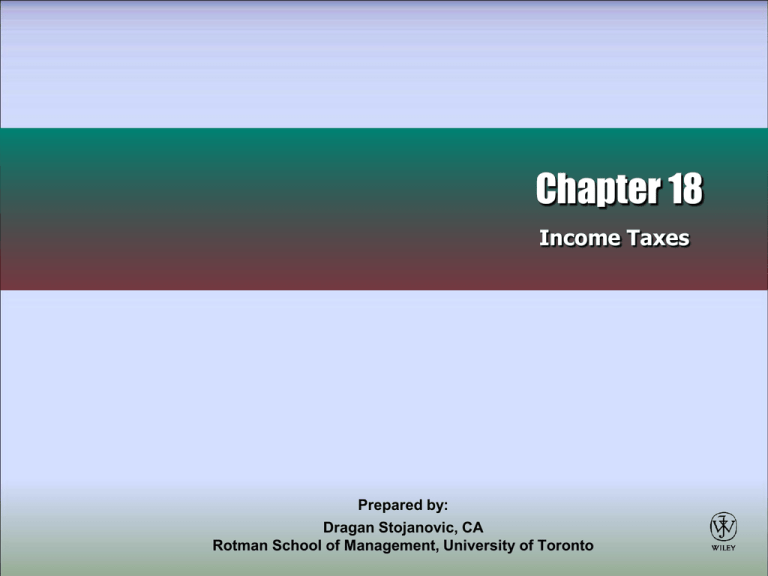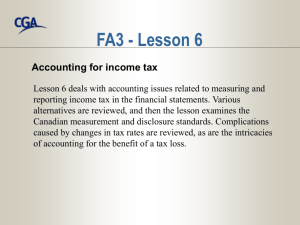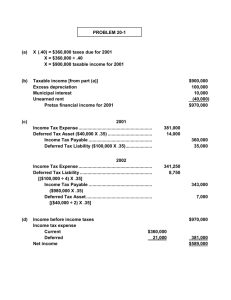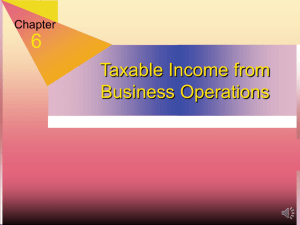
Chapter 18
Income Taxes
Prepared by:
Dragan Stojanovic, CA
Rotman School of Management, University of Toronto
Income Taxes
Current
Income
Taxes
Future/Deferred
Income Taxes
Income Tax Loss
Carryover Benefits
•Tax basis
•Accounting
income and
taxable income
•Future income tax
liabilities
•Introduction to tax
losses
•Calculation of
taxable income
•Calculation of
current income
taxes
•Future income tax
assets
•Income tax
accounting objectives
•Multiple differences
illustrated
•Tax rate
considerations
•Loss carryback
illustrated
Presentation,
Disclosure, and
Analysis
•Balance sheet
presentation
•Loss carryforward
illustrated
•Income and other
statement
presentation
•Carryforward with
valuation allowance
•Disclosure
requirements
•Review of future
income tax asset
account
•Analysis
IFRS /
Private
Entity GAAP
Comparison
•Comparison
chart
•Looking ahead
•Outstanding
conceptual questions
2
Income Taxes
Current
Income
Taxes
Future/Deferred
Income Taxes
Income Tax Loss
Carryover Benefits
•Tax basis
•Accounting
income and
taxable income
•Future income tax
liabilities
•Introduction to tax
losses
•Calculation of
taxable income
•Calculation of
current income
taxes
•Future income tax
assets
•Income tax
accounting objectives
•Multiple differences
illustrated
•Tax rate
considerations
•Loss carryback
illustrated
Presentation,
Disclosure, and
Analysis
•Balance sheet
presentation
•Loss carryforward
illustrated
•Income and other
statement
presentation
•Carryforward with
valuation allowance
•Disclosure
requirements
•Review of future
income tax asset
account
•Analysis
IFRS /
Private
Entity GAAP
Comparison
•Comparison
chart
•Looking ahead
•Outstanding
conceptual questions
3
Fundamentals
Accounting income (per GAAP) ≠ Taxable
income (per Income Tax Act)
Accounting income → Income tax expense
(current and future)
Taxable income → Income tax payable and
current income tax expense
Income tax expense ≠ Income tax payable
4
Accounting Income and
Taxable Income:
Reconciliation of Accounting Income
and Taxable Income:
Accounting income
± differences
= Taxable income
Taxable income × current tax rate =
taxes payable and current income tax
expense
5
Future Tax Liability Example
Chelsea Inc. - 2010
Accounting
Revenue
Tax
$130,000
$100,000
60,000
60,000
Income
$ 70,000
$ 40,000
Tax @ 40%
$ 28,000
$ 16,000
Expenses
6
Future Tax Liability Example
Chelsea Inc.
2012
2010
2011
$70,000
Accounting Income
$70,000
$70,000
Adjust for revenue
taxable in future
period
(30,000)
20,000
10,000
Taxable Income
$ 40,000
$ 90,000
$ 80,000
Tax payable @
40%
$ 16,000
$ 36,000
$ 32,000
7
Permanent, Timing, and
Temporary Differences
• Taxable income is determined by starting with
accounting income and adjusting it for
permanent and reversible (or timing)
differences in the year
8
Permanent Differences - Examples
• Items, recognized on income statement,
but never for income tax purposes:
• Non-tax-deductible expenses (e.g. fines,
golf dues, expenses related to non-taxable
revenue)
• Dividends from taxable Canadian
corporations
• Items, recognized for tax purposes, but not
for
financial accounting purposes:
• Depletion allowance of natural resources in
excess of cost
9
Summary of Permanent Differences
Sources of PERMANENT DIFFERENCES
Some items
are recorded
in books
but never
on tax return
Other items
are never
recorded in books
but recorded
on tax return
No future tax effects
for permanent differences
10
Reversible Differences
• Are treated the same for books and tax—but in
different periods.
• Relate to income statement differences
• Cause the balance of a temporary difference to
change from period to period
• Originating timing difference
– Cause of the initial difference (e.g. the $30,000
non taxable revenue in 2010 in Chelsea
example)
• Reversing timing difference
– Causes a temporary difference to decrease (e.g.
the $20,000 and $10,000 amounts taxed in 2011
and 2012 in Chelsea example)
11
Calculation of Current Income
Taxes
Two methods:
1. Taxes payable method
• Allowed under PE GAAP
• Current Income Taxes
= Taxable income x Tax rate
2. Future income taxes method
• Called balance sheet liability method in IFRS
• Required by IFRS and option under PE GAAP
• Starts with Current Income Taxes and
• Adjusts for future (or “deferred”) income tax
assets and liabilities,
• To also get future (or “deferred”) income tax
expense
12
Terminology
• PE GAAP and IFRS use different terminology for the
asset and liability approach to income taxes
• Under PE GAAP
– This method is called the future income taxes method
– Related tax accounts are called future income tax
assets, future income tax liabilities, and future income
tax expense
• Under IFRS
– This method is called the balance sheet liability
method
– Related tax accounts are called deferred income tax
assets, deferred income tax liabilities, and deferred
income tax expense
• As a result, you will see the terms “future” and “deferred” used
interchangeably.
13
Income Taxes
Current
Income
Taxes
Future/Deferred
Income Taxes
Income Tax Loss
Carryover Benefits
•Tax basis
•Accounting
income and
taxable income
•Future income tax
liabilities
•Introduction to tax
losses
•Calculation of
taxable income
•Calculation of
current income
taxes
•Future income tax
assets
•Income tax
accounting objectives
•Multiple differences
illustrated
•Tax rate
considerations
•Loss carryback
illustrated
Presentation,
Disclosure, and
Analysis
•Balance sheet
presentation
•Loss carryforward
illustrated
•Income and other
statement
presentation
•Carryforward with
valuation allowance
•Disclosure
requirements
•Review of future
income tax asset
account
•Analysis
IFRS /
Private
Entity GAAP
Comparison
•Comparison
chart
•Looking ahead
•Outstanding
conceptual questions
14
Temporary Differences
= accumulated timing differences
= difference between book value of an
asset or liability and its tax value
• Is either a deductible temporary difference
(i.e. will be deducted from accounting
income in calculating taxable income in the
future), giving rise to a future tax asset, OR
15
Temporary Differences
• …a taxable temporary difference (i.e. will be
added to accounting income in calculating
taxable income in the future), giving rise to a
future tax liability.
16
Future Tax Asset and
Future Tax Liability - Sources
• Future tax accounts on the balance sheet may
be a:
– Future income (or “deferred”) tax liability, or
– Future income (or “deferred”) tax asset
17
Future Tax Asset and
Future Tax Liability - Sources
• Future tax liability
– When the future recovery of an asset, or future
settlement of a liability, that is reported on the
balance sheet will result in paying future income
taxes
– Arises from taxable temporary differences
• Future tax asset
– When the recovery of an asset or settlement of a
liability results in future income tax reductions or
benefits
– Arises from deductible temporary differences
18
Future Tax Liability Example
Chelsea Inc. - 2010
Books
Tax
Accounts receivable
$30,000
0
Income reported
in 2010
$70,000
$40,000
Tax rate = 40%
Future Income tax liability
(30,000 x 40%)
12,000
Income tax payable
(40,000 x 40%)
16,000
Income Tax Expense (total)
28,000
19
Chelsea Inc. – example continued
2011
2012
Total
Future taxable
amounts
$20,000
$10,000
$30,000
Future tax rate
40%
40%
40%
Future income
tax liability
$ 8,000
$ 4,000
$ 12,000
20
Recording Journal Entries
– e.g. Chelsea Inc. -2010
Journal Entries:
Current Income Tax Expense 16,000
Income Tax Payable
16,000
Future Income Tax Expense
Future Income Tax Liability
12,000
12,000
21
Future Income Tax Liability
Net Assets reported
Accounts receivable (in
assets)
Future income tax liability
(in liabilities)
Net assets reported
Note: Balance sheet
reflects eventual cash
impact of recovering the
A/R
End of
2010
End of
2011
$30,000
$10,000
12,000
4,000
$ 18,000
$ 6,000
22
Future Tax Asset – Example
• Cunningham Inc. sells microwave ovens with
a 2 year warranty
• In 2011, estimated warranty expense is
$500,000
• Actual warranty costs are $300,000 in 2012
and $200,000 in 2013
23
Future Income Tax Asset:
Example
Books
Warranty liability
Tax
$500,000
0
Tax rate = 40%
Future Income tax asset
(500,000 x 40%)
200,000
Income tax payable (assumed)
(Taxable Income x 40%)
600,000
Income Tax Expense (total)
400,000
24
Future Income Tax Asset:
Example
Journal Entries:
Current Income Tax Expense 600,000
Income Tax Payable
600,000
Future Income Tax Asset
200,000
Future Income Tax Expense
200,000
The total income tax expense of $400,000 is
made up of a current tax expense of $600,000
and a future income tax benefit of $200,000
25
Future Income Tax Asset:
Example
In subsequent years (2012 and 2013):
- warranty expense of $500,000 deducted
for tax, but not for books
- Income taxes payable reduced by
$500,000 × 40% = $200,000
- Entry in future, therefore:
Income tax expense
$x
Future income tax asset
$ 200,000
Income taxes payable
$x − 200,000
26
Valuation of Future Income Tax
Asset
• Income tax assets and liabilities meet the
conceptual framework conditions for
recognition as “asset” or “liability”
• Future income tax assets must be reviewed
at year end to ensure they are not reported at
more than recoverable amount
– This depends on whether taxable income will
be earned in the future, against which
temporary differences can be deducted
27
Income Tax Expense
= total of current tax expense (or benefit) and future
tax expense (or benefit)
Current income tax expense (or benefit)
= income taxes payable/receivable, based on
taxable income for current year
Future income tax expense (or benefit)
= amount of adjustment needed to the future
income tax asset/liability account on the balance
sheet
28
Future Tax Rates
• Should use the rates that are expected to
apply when the tax assets are realized or
the tax liabilities are settled
– i.e. the enacted rate (or substantively
enacted) at the balance sheet date
29
Future Tax Rates
• The effect of future tax rate changes
should be immediately recognized on all
future tax accounts
• Rate changes are treated as an
adjustment to the future income tax
expense/benefit
• Accounting standards prohibit discounting
of future income tax assets and liabilities
• IFRS requires separate disclosure of future
tax expense or benefit due to a change in
tax rates
30
Future Tax Rate - example
Hostel Corp. had the following at end of 2009:
Property, plant, and equipment:
Net book value (NBV)
= $4,000,000
Tax value (Undepreciated
capital cost, UCC)
= 1,000,000
Taxable temporary difference
= 3,000,000
(to reverse by $1,000,000 each year in 2011,
2012 and 2013)
Tax rate
40%
Future tax liability
1,200,000
31
Future Tax Rate - example
Assume a new income tax rate is enacted from
40% to 35%, effective January 1, 2012
• Recalculate Future tax liability as follows:
2011 $1,000,000 x 40% = $400,000
2012 $1,000,000 x 35% = $350,000
2013 $1,000,000 x 35% = $350,000
Total
$1,100,000
Required Adjusting Entry:
Future Income Tax Liability 100,000
Future Income Tax Benefit
100,000
(1,200,000 - 1,100,000)
32
Income Taxes
Current
Income
Taxes
Future/Deferred
Income Taxes
Income Tax Loss
Carryover Benefits
•Tax basis
•Accounting
income and
taxable income
•Future income tax
liabilities
•Introduction to tax
losses
•Calculation of
taxable income
•Calculation of
current income
taxes
•Future income tax
assets
•Income tax
accounting objectives
•Multiple differences
illustrated
•Tax rate
considerations
•Loss carryback
illustrated
Presentation,
Disclosure, and
Analysis
•Balance sheet
presentation
•Loss carryforward
illustrated
•Income and other
statement
presentation
•Carryforward with
valuation allowance
•Disclosure
requirements
•Review of future
income tax asset
account
•Analysis
IFRS /
Private
Entity GAAP
Comparison
•Comparison
chart
•Looking ahead
•Outstanding
conceptual questions
33
Tax Loss Carryback and
Carryforward
• The amount reported is the tax calculated from the
loss
• May be carried back three years, or forward for the
next twenty years
• When applying the carry back, it is usually applied
to the oldest available year first
• The benefit of a tax loss carryforward is recorded
(i.e. booked) if it is more likely than not that taxable
income will be earned in future periods to apply it
against
34
Tax Loss Carryback
• Refile prior year’s tax returns, reduce prior
taxable incomes with current year’s loss
• Claim back taxes previously paid:
Income Tax Refund Receivable xx
Current Income Tax Benefit
xx
• If loss still remains, carry it forward
35
Tax Loss Carryforward
Can you recognize (book) the tax benefit of a
loss carryforward?
•If more likely than not (i.e. probable) that benefit
will be realized (i.e. company will generate
taxable income in the future to apply loss
against), then recognize tax benefit as an asset:
Future Income Tax Asset xx
Future Income Tax Benefit
xx
36
Tax Loss Carryforward
(Cont’d)
• If future taxable income not likely (i.e. not
likely that benefit will be realized), then do not
record the tax benefit
• Instead, report existence of loss carryforward
in notes to the financial statements
• Disclose the amounts and expiry dates of
unrecognized income tax assets related to
the carryforward of unused tax losses
37
Tax Loss Carryforward (Cont’d)
Assuming tax benefit was recognized as a
Future Tax Asset, when co. applies the losses
against taxable income in the future:
Future income tax expense xx
Future income tax asset
xx
38
Tax Loss Carryforward
(Cont’d)
• If benefit was not “booked” and company does
generate taxable income in the future and uses the
unrecognized losses to reduce taxable income:
Income tax payable
xx
Current income tax benefit
xx
• Separate disclosure of the tax benefit from realization
of unrecorded loss carryforward is not required under
PE GAAP, but is required under IFRS if it makes up a
major component of tax expense
39
Carryforward with Valuation
Allowance
• This approach permitted under PE GAAP (but not
permitted under IFRS)
• Assuming a $150,000 loss carryforward where it is
unlikely that benefit will be realized in the future:
Future Income Tax Asset
60,000
Future Income Tax Benefit
60,000
(150,000 x 40%)
Future Income Tax Expense 60,000
Allowance to Reduce Future Income Tax
Asset to Expected Realizable Value
60,000
40
Carryforward with Valuation
Allowance (continued)
• The second entry indicates that the company
cannot conclude that it is more likely than not
that the company will benefit from the tax loss
in the future
• The financial statements would be the same
whether the allowance method is used or the
future income tax asset is not recognized at
all
41
Income Taxes
Current
Income
Taxes
Future/Deferred
Income Taxes
Income Tax Loss
Carryover Benefits
•Tax basis
•Accounting
income and
taxable income
•Future income tax
liabilities
•Introduction to tax
losses
•Calculation of
taxable income
•Calculation of
current income
taxes
•Future income tax
assets
•Income tax
accounting objectives
•Multiple differences
illustrated
•Tax rate
considerations
•Loss carryback
illustrated
Presentation,
Disclosure, and
Analysis
•Balance sheet
presentation
•Loss carryforward
illustrated
•Income and other
statement
presentation
•Carryforward with
valuation allowance
•Disclosure
requirements
•Review of future
income tax asset
account
•Analysis
IFRS /
Private
Entity GAAP
Comparison
•Comparison
chart
•Looking ahead
•Outstanding
conceptual questions
42
Balance Sheet Presentation
• Under IFRS
– All deferred tax assets and liabilities are recorded as
noncurrent
• Under PE GAAP
– Future tax asset or liability is classified as current or
noncurrent based on the classification of the underlying
asset or liability giving rise to the specific temporary
difference
– If the a future asset or liability is not related to specific
asset or liability (e.g. expensed research costs deferred
for tax purposes), classification is based on date that
temporary difference is expected to reverse or tax
benefit expected to be realized
43
Intraperiod Tax Allocation
• Income tax expense is reported with its
related item, such as discontinued operations,
other comprehensive income, adjustments to
RE, etc.
• Intraperiod Tax Allocation
– Tax expense is allocated within the financial
statements of the current period
• Interperiod Tax Allocation
– Tax expense is allocated between years,
and results in the recognition of future
income taxes
44
Intraperiod Tax Allocation:
Example
• Assume the following information for Copy
Doctor Inc.:
– Tax rate of 35%
– A loss from continuing operations of $500,000
– Income from discontinued operations of
– Unrealized holding gain of $25,000 on investment
accounted for at FV-OCI
• Prepare the journal entries to record current and
future tax expenses
45
Intraperiod Tax Allocation:
Example
Current Income Tax Expense
(discontinued operations)
241,500
Current Income Tax Benefit
(continuing operations)
175,000
Income Tax Payable
66,500
Calculations:
• income of 690,000 x 35% = 241,500 expense
• loss of 500,000 x 35% = 175,000 benefit
46
Intraperiod Tax Allocation:
Example
Future Income Tax Expense (OCI)
Future Income Tax Liability
8,750
8,750
Calculations:
• 25,000 x 35% = 8,750
47
Disclosure Requirements
• IFRS has more extensive disclosure requirements than
PE GAAP, including:
–
–
–
–
–
–
Major components of income tax expense or benefits
Sources of both current and future taxes
Amount of current and future tax recognized in equity
Reconciliation of effective and statutory tax rates
Information about unrecognized future tax assets
Information about each type of temporary difference and
future tax asset or liability recognized on statement of
financial position
48
Analysis
• Extensive disclosure help users asses
quality of earnings, as well as assist in
better prediction of future cash flows
49
Outstanding Conceptual Issues
• Asset-liability method (or balance sheet liability
approach) is considered most conceptually sound
method of income tax accounting
• Significant conceptual questions remain about:
– Lack of discounting (and therefore, no difference
between short-term deferral and long-term deferral)
– Recognition of future tax assets
50
Income Taxes
Current
Income
Taxes
Future/Deferred
Income Taxes
Income Tax Loss
Carryover Benefits
•Tax basis
•Accounting
income and
taxable income
•Future income tax
liabilities
•Introduction to tax
losses
•Calculation of
taxable income
•Calculation of
current income
taxes
•Future income tax
assets
•Income tax
accounting objectives
•Multiple differences
illustrated
•Tax rate
considerations
•Loss carryback
illustrated
Presentation,
Disclosure, and
Analysis
•Balance sheet
presentation
•Loss carryforward
illustrated
•Income and other
statement
presentation
•Carryforward with
valuation allowance
•Disclosure
requirements
•Review of future
income tax asset
account
•Analysis
IFRS /
Private
Entity GAAP
Comparison
•Comparison
chart
•Looking ahead
•Outstanding
conceptual questions
51
Looking Ahead
• Additional changes are expected as IASB
and FASB revisit the income tax standard
52
COPYRIGHT
Copyright © 2010 John Wiley & Sons Canada, Ltd.
All rights reserved. Reproduction or translation of
this work beyond that permitted by Access Copyright
(The Canadian Copyright Licensing Agency) is
unlawful. Requests for further information should be
addressed to the Permissions Department, John
Wiley & Sons Canada, Ltd. The purchaser may make
back-up copies for his or her own use only and not
for distribution or resale. The author and the
publisher assume no responsibility for errors,
omissions, or damages caused by the use of these
programs or from the use of the information
contained herein.
53






